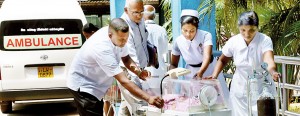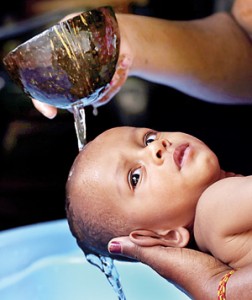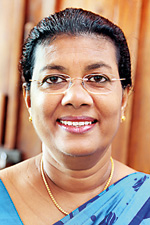Wheels in motion to save little lives

A baby with heart issues being brought to the LRH, by the Neonatal Transport Team of the Peradeniya Hospital for further tests and expert opinion. Pix by M.A. Pushpa Kumara
A baby’s cry disturbs the stillness of a humble home in Godakumbura, Mahagama close to Bulathsinhala. There is gurgling laughter when Sithu is cuddled and snuggled by mother K.M. Nadeesha Tharangamali.
The situation in that home may have been different and tragic if this baby boy was born several years ago. Although he was born prematurely through a Caesarian-section at the Horana Hospital, fortunately for this family there was a different kind of service, not the usual one, to help minimize the dangers faced by neonates (babies in the first month of life). Sithu was rushed to the Lady Ridgeway Hospital (LRH) for Children through the Neonatal Transport Service during a pilot project initiated in June 2013 to check out its effectivity.
Now the Neonatal Transport Service has been embraced by Sri Lanka, with its national roll-out in phases being launched on January 26, this year, with two other major centres of excellence in addition to the LRH providing this invaluable service. While the LRH covers the Western Province, the Karapitiya Teaching Hospital and the Peradeniya Teaching Hospital do so for the Southern and Central Provinces respectively.

It’s bath-time for Sithu the neonate who got a better chance at survival
Numerous mothers and newborns face a situation similar to that of Nadeesha and her baby. Sithu was due to be born in October last year, but on August 6, Nadeesha’s blood pressure rose while the heart-beat of the baby she was carrying slowed down, signalling danger.
The Horana Hospital doctors reacted quickly and calling the LRH immediately assured her that while a C-section was imminent, her prematurely-born baby would be transferred to the LRH thereafter under the best possible care to get the best possible medical attention at a tertiary centre, recalls Nadeesha.
So Sithu, born prematurely at 29 weeks instead of the required 40 weeks, with a birth-weight of 0.795kg was quickly shown to groggy Nadeesha and whisked off to LRH, utilizing the Neonatal Transport Service.
Explaining why Sri Lanka needs the Neonatal Transport Service, LRH’s Consultant Paediatrician-in-Charge of the Neonatal Intensive Care Unit (NICU), Dr. Ramya de Silva, goes to statistics to prove her point.
The Neonatal Mortality Rate (NMR) is 6.2 per 1,000 live births, she says, adding that this figure has been declining very slowly over the last two decades. This is despite 30 NICUs, with experienced and skilled Consultant Paediatricians at the helm, being spread across the country. An analysis has clearly indicated that 24% of all neonatal deaths are due to prematurity and most of these deaths are within the first week of life. Ten percent or 34,500 babies are born pre-term every year of the 345,000 live births.
Death is not the only tragedy they face. “Even if they survive, the implications of being born pre-term extend beyond the neonatal period. The impacts are seen throughout the life-cycle. Many survivors face a life-time of disabilities, cerebral palsy, learning difficulties, chronic lung disease and visual and hearing impairment. They are also at risk of developing non-communicable diseases (NCDs) in later life. To prevent these disabilities, optimal care has to be provided as soon as the baby is born,” reiterates Dr. de Silva who is also President-elect of the Sri Lanka College of Paediatricians and former President of the Perinatal Society.

Dr. Ramya de Silva
While Sri Lanka has a low and commendable Infant (first year of life) Mortality Rate of 8.8 per 1,000 live births, the Under-five Mortality Rate is 11.3, MediScene learns. Neonatal deaths contribute to 60% of under-5 mortality and 74% of infant mortality.
“The only way to reduce these deaths is by reducing neonatal deaths,” points out Dr. de Silva, explaining that the baby may survive, but the transfer process itself to a tertiary-care centre could be deleterious to the little one. Usually, the Paediatrician of the hospital in which the baby is born will make a round of calls to check the bed-availability of a tertiary hospital close-by. Often it would depend on personal contacts.
If a bed is available, the pre-term baby transfer would be carried out without the needed facilities, she says, painting the image of the baby being bundled onto a cot or trolley and loaded onto an ambulance. The baby’s temperature would go down drastically and to keep him/her warm a hot water bottle would be used. Gradually the hot-water bottle would become cold. Most such babies would have difficulty in breathing and a tube would be inserted which would have to be hand-ventilated by the accompanying doctor who would do so while standing, being swayed this way and that due to the movement of the speeding ambulance. The tube could slip into the lung or penetrate through the trachea and injure the food pipe. Even when travelling long distances, there would only be a small cylinder of oxygen.
With the need to deliver the baby as soon as possible to the tertiary hospital, the driver would accelerate and decelerate which would jolt the baby about and would not be good for the tiny brain.
“All these lead to major problems. If the temperature is low there could be a cascade of problems – brain haemorrhage, lung haemorrhage and low blood sugar. They would then be more vulnerable to infections and respiratory problems would worsen. The baby might survive but at what cost?” asks Dr. de Silva.
Once again, she talks with facts in hand – audits at LRH have shown babies arriving with hypothermia (low temperature), hypoglycaemia (low blood sugar) and hypoxia (low oxygen), which are detrimental to neuro-developmental intact survival.
This is why the best option for such babies is a transport service dedicated to neonates and the country has seen its vital need after data in the form of proof from the pilot project were presented to the Sri Lanka College of Paediatricians and the Perinatal Society of Sri Lanka. The pilot project was set in motion with support from the Family Health Bureau of the Health Ministry, the World Health Organization and UNICEF which facilitated the training of local personnel by a team from the John Radcliffe Hospital in Oxford, United Kingdom, headed by Associate Dean, Oxford Deanery and Consultant Neonatologist Dr. Amit Gupta. The pilot project linked LRH with the five hospitals of Khethumathi, Wathupitiwela, Horana, Homagama and Negombo.
One tiny beneficiary, among many, of this Neonatal Transport Service is Sithu. “Hondatama innawa. Kriyakarakam hari,” says Nadeesha, adding with joy that her baby boy is doing fine and keeping to all the developmental milestones.


